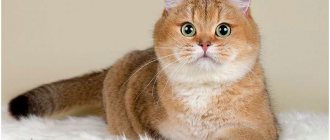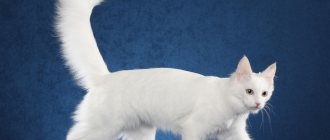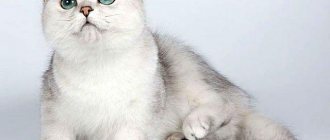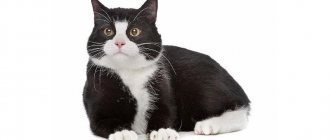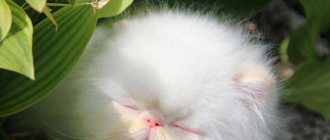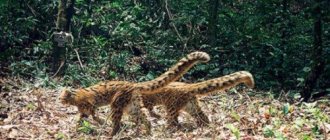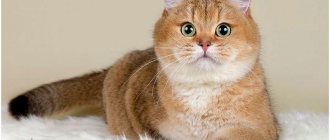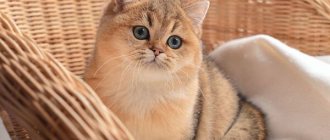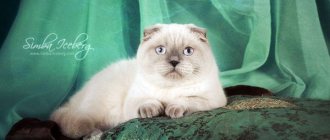The Golden Chinchilla is a cat of an original and rare color, which is most common among the British, Scots and Persians. It was bred artificially by crossing representatives of different breeds.
These animals are extremely popular and invariably win “feline beauty” competitions. But in order to find a purebred pure golden chinchilla kitten, you need to learn about its characteristics and standard requirements.
History of the unique color
The first golden chinchilla kittens were born in a litter of silver chinchilla Persian cats. Breeders were interested in the unusual coloring, but were unable to find the gene responsible for it.
This is interesting. Silver chinchillas have a white coat, and the darkened ends of the hair create the effect of a thrown veil.
Experts decided that the golden pigment appears as a result of the interaction of a whole group of genes. And then the breeders began targeted selection to consolidate the desired trait in the genotype of the animals.
British golden chinchilla cats were bred in the UK. They were created by crossing a Golden Persian and a Smoky Briton. As a result of systematic work, a cat named Silver Lambkin appeared in 1889, who was recognized as the ancestor of this variety.
A little later, Scottish cats began to be crossed with Golden Persians and the British. Animals of this color looked very impressive.
This is interesting. Golden chinchilla cats are often called royal or royal.
Types of British chinchillas
According to the breed standard, pets' fur should be shiny and elastic. Very soft or too close-fitting fur is considered a fault. Depending on the length of the coat, the following types of chinchilla cats are distinguished:
- short-haired;
- long-haired;
- lop-eared
Shorthair
The representative of the species has a short type of coat with a dense, thick undercoat. The chinchilla cat has all the characteristics of a British Shorthair.
Longhair
Not all felinological organizations and clubs recognize the British with long fur. Some breeders express the opinion that it is undesirable to separate these individuals into a separate species. Since the experts sought precisely to breed “beaver” fur, springy, plush.
The British long-haired chinchilla cat got the size of its fur from mating with Persians. Such experiments were abandoned to preserve the purity of the breed, but the distinctive gene remained. You should not be surprised if, as a result of crossing two short-haired cats, a long-haired pet is born.
Fold
At the age of 20-23 days, the ears of the babies are not formed, but closer to 1 month of life it is clearly visible whether they are pressed to the head or not. The British received drooping ear tassels from Scottish descendants. There is an opinion that there are no lop-eared Britons.
Genetics of color
A polygenic complex is responsible for the golden chinchilla color, providing a warm shade of the undercoat and a lightened background color:
- melanin inhibitor – absorbs hair pigment, starting from the hair root;
- agouti and tabby (tabby) - forms a pattern;
- erizer – gene eraser, gives the undercoat a warm shade.
The golden chinchilla color includes several varieties depending on the color of the hair tips:
- black;
- chocolate;
- lilac;
- faun (fawn);
- cinnamon (cinnamon);
- blue.
The golden color is a recessive trait in relation to the silver color. Kittens of this color can be obtained in the following cases:
- both manufacturers have a golden color;
- parents are silver chinchillas, but are carriers of the golden gene;
- one producer is golden, the second is silver, but his genotype contains genes for goldenness.
Characteristics and color features
Regardless of the breed, chinchilla cats should have hair with a smooth color transition from soft pink to dark at the tips. The undercoat can be of different shades: from light peach to red. There should be no dull or grayish areas on the body.
The color is considered chinchilla if the dark tip occupies 1/8 of the length of the hair. If 1/3 is painted, the color is called shaded, if 1/2 is called golden tabby.
In chinchillas, the pigmentation of the iris is usually green or bluish-green. There is a dark brown or black edging on the eyelids, lips and nose. The lobe is colored pink, the paw pads are black or brown.
Information about the breed and color of the cat is indicated in the pedigree. Special designations are used for this.
Breed:
- BRI - British;
- PER – Persian;
- SFL – Scots Fold Shorthair;
- SFS – long-haired Scots Fold;
- SCS – Scots with erect ears, shorthair;
- SCL – long-haired, erect-eared Scotsman.
Color:
- y – golden;
- a – blue;
- b – chocolate;
- c – lilac;
- n – black;
- o– cinnamon;
- q – faun.
Picture code:
- 11 – shaded;
- 12 – chinchilla;
- 21 – linx (tabby pattern on the face and paws);
- 22 – marble;
- 23 – brindle;
- 24 – spotted;
- 25 – ticked (each hair has more than two dark zones);
- 33 – point (reminiscent of the Siamese color).
At the end they put numbers indicating eye color:
- 64 – green;
- 61 – blue;
- 62 – yellow.
For example, a Scottish fold short-haired chinchilla of golden color with black tips of hairs and green eyes would be written as follows: SFLny 12 64.
Features of the breed and character of the golden chinchilla cat
The British Golden Chinchilla appeared in Great Britain as a result of crossing other cat breeds that had the desired qualities for the result. And fluffy Persian cats and smooth-haired gray British cats acted as producers, so the resulting look has very thick gray fur of medium length.
Initially, chinchillas were only gray, but breeders did not stop there and began breeding golden coat color. The red color gene was present in cats due to the presence of red Persians in matings; it was only necessary to fix it.
The golden chinchilla is a cat that has inherited from its ancestors not only gorgeous appearance, but also a noble character, in which pride is perfectly combined with tenderness and meekness.
A distinctive and unusual feature is the animal's fur. It would seem that the uniform golden color throughout the cat’s body, upon closer examination, does not seem so monotonous.
All hairs of a purebred chinchilla have a pronounced gradient - a smooth transition from a soft peach color at the base to the black tips of the hairs. Thus, the color of the golden chinchilla has a slight black shade, which is especially pronounced on the back and sides of the cat.
Golden Britons become true friends for all family members. The aristocratic nature does not allow animals to forget about the rules of etiquette - always go to the toilet in the tray, eat in the kitchen, do not scratch the furniture, do not bother the owner with loud meows.
If there are small children living in a family with a golden chinchilla, there is no need to be afraid of aggression on its part, even if the children do not yet understand that it is forbidden to pull a cat’s whiskers or tail. Representatives of the breed have a flexible mind and understand that it is impossible to be aggressive towards cubs, even if they are not cats, but human ones.
However, golden chinchilla cats, with all their love for their owner and his family, are jealous of their own territory and personal space. So, if the cat does not want to “hugg” at the moment and makes it clear to the owner, it is better to give her time to mind her own, cat’s, affairs. For example, washing, sleeping or hunting your own tail.
Golden Chinchilla Standards
For the first time, the golden chinchilla color was included in the standard of Persian cats. Now it is found in many breeds for which the silver chinchilla color is recognized.
Preference is given to cats with a uniform golden undercoat without a gray area at the roots. When the color first appeared, such animals were still used for breeding, but now they are increasingly not allowed to breed.
There is no single standard regulating the color of the golden chinchilla. Experts evaluate animals in accordance with documents approved for a specific breed by the World Cat Federation:
- British cats are stocky, massive and muscular. The head is round, with a wide skull and pronounced cheeks. The ears are small, set wide, and the tips are slightly rounded. The tail is thick and curves upward. The coat is raised, dense and short.
- Scottish - divided into fold-eared (Scottish fold) and straight-eared (straight). The first ones have small ears, the tips hanging forward. The limbs are short and thick. Straights have erect ears and can be small or medium in size. The limbs are slightly longer and lighter.
- Persian - distinguished by rectangular body lines. Legs are strong and short. The head is large, the forehead is sloping (other chinchillas have a rounded forehead).
Golden chinchillas have ears covered with dense and short fur. The eyes are very large and expressive.
Description
British Golden Chinchillas tend to be soft and round in shape. The fur of representatives of this breed is very matted and thick, and the undercoat is also printed. The fur is so soft that it resembles an arctic fox.
British chinchillas boast well-developed muscles; their front and rear legs sometimes look shorter than they actually are.
The tail of golden chinchillas is large, thick and fluffy, the hair on it is longer than on the entire body.
The head and ears are small. The ears are slightly sloping and are located at a sufficient distance from each other. The eyes are large.
The coat of golden chinchillas is only partially colored. The undercoat usually has a cream, apricot or milky color, and the coat itself is gray-red, that is, each tip is only slightly painted in a dark color, which creates such an amazing shade of playing gold on the fur coat.
A distinctive feature of golden chinchillas is the eyeliner around the eyes and nose that is dark brown, almost black.
Adult cats can gain weight up to 8 kg, while cats weigh up to 4-5 kg. It is also worth noting that spayed and neutered animals can weigh up to 10 kg.
British
British chinchillas are usually smaller. They ripen late - full formation of the exterior is completed by 3 years.
The wool has a soft and silky texture. There are 2 varieties: British shorthair and longhaired chinchillas. The latter have elongated fur, which is inherited from Persian cats.
The most common are golden chinchillas with green eyes, but there are cats with blue and yellowish irises.
Scottish
The Scottish chinchilla cat has the same color as the British one. She has a plush coat, a dense undercoat of a warm shade, dark lining of the eyelids, lips and nose, and brown paw pads.
The eyes are most often green, but can also be blue. These animals have soft, rounded body shapes, which provide developed muscles and thick hair.
Tortoiseshell colors
Not everyone likes this color; there are two colors in the animal’s coat. The coat should be soft and thick, the shades should be mixed evenly. The presence of “socks” on the paws or weakly defined short stripes (for example, on the muzzle) is acceptable. The eyes are golden or orange-copper, the nose and pads can be pigmented black or pink. Genetics has determined that tortoiseshell color is characteristic only of cats. Offspring can inherit different colors. This category includes:
- Tortoiseshells are black.
- Blue-cream and lilac-cream.
- Chocolate cream cats.
Persian
Persian chinchillas are slightly smaller than their counterparts. They are harmoniously built, distinguished by fine bones and elegance, but at the same time strong and resilient. In the USA, larger cats are bred, which are very similar in size and build to standard Persians.
The coat of Persian golden chinchillas is long and dense. The fur shimmers beautifully in the light. The cat may have emerald or bluish eyes with a brown rim. The soft pink nose is small and neat.
Description of the breed (requirements for the standard)
British and Scottish cats have round, soft shapes and limbs that are proportional and harmonious. The compactness and roundness is achieved not only due to the thick coat, but also because representatives of the breed have very developed muscles. The front and hind legs are the same length, the tail has a slightly rounded tip.
The head is small but massive, with a well-defined chin. There is always a small plane on the forehead, however, if you look in profile, there will be a noticeable depression between the nose and forehead.
The ears of a chinchilla cat are wide and small, and the fur covers the back of them with a uniform, dense carpet. Huge eyes are set wide and very expressive, green in color (less often golden).
Character and behavior of elite pets
Chinchillas are considered the aristocrats of the cat family. They are distinguished by noble manners, a sharp mind and excellent memory.
The characteristics of golden chinchilla cats are determined by the breed:
Each animal has individual character traits. Therefore, the habits and behavior of pets may differ slightly from the description given.
Character
British chinchilla cats are distinguished by aristocratic manners, calmness, and a good nervous system. Up to a year old, babies are very active and love to play. Adult pets are most often balanced and treat their owner as a friend. The British do not like to sit on their hands; they prefer to approach them themselves for a portion of affection.
Animals understand the situation very well and are able to manipulate the owner and family members. Plush beauties most often cannot stand strangers; there are known cases of hostility towards drunken visitors to the house. But by purchasing a British chinchilla cat, a person receives a devoted companion. The pet is attached to the house and can resort to tricks if the owner is forced to say goodbye to it. Sometimes they hide or pretend to be sick when strangers appear.
British Chinchillas get along well with other pets indoors. But the arrival of a new pet must be planned. It is necessary to separate the arriving baby from the old friend. Gradually allow animals to be together. If you do not provide for the behavior of pets, you can get sick and sick in cats.
British chinchillas are prone to depression. They buy toys and mazes for the animal. A mobile, active pet eats well and looks great.
The description of the breed and character of the British chinchilla shows: pets get along well with children. But you should not allow your child to squeeze and knead the baby immediately after coming into the house. The furry baby is given time to get used to the new home, food, smells and sounds.
Features of care and maintenance
Owners of golden chinchilla cats have to comb their luxurious coat at least 2 times a week to keep it tidy. During the molting period, the procedure is carried out daily.
Chinchillas have a two-layer coat. It must be combed in 2 stages: first along the hair growth, then against it. It is recommended to use a fine-toothed comb or a special glove.
Cats are bathed as needed, but not more than once every 3-4 months. Due to frequent washing, the coat becomes dry and brittle. Dry products are used as a replacement for regular shampoos.
Otherwise, care for golden chinchillas is standard:
The pet should have a separate place to rest, a variety of toys and a cat scratching post. Animals quickly learn to use the toilet, but the tray must be large and comfortable, since the golden chinchilla color is found in fairly large breeds.
For your information. Some cats like to walk on a leash or harness. However, most of them are satisfied with being in a confined space - a house or apartment.
Feeding the animals
For feeding golden chinchillas, like other purebred cats, high-quality ready-made food with a protein content of at least 30-35% is suitable. They have a balanced composition and fully satisfy the needs of the animal’s body.
The following brands have proven themselves well:
- 1st Choice;
- Hills;
- Acana;
- Leonardo;
- Sanabelle Bosch;
- Pro Plan.
If the owner chooses a natural diet, then it is based on meat - turkey, chicken, veal. The meat needs to be frozen for 2-3 days. It is given raw, cut into pieces and doused with boiling water. These measures are necessary to destroy parasites and bacteria.
Cats do not refuse offal. Liver, lung, heart, tripe are suitable for feeding. They must be boiled for several hours.
Also included in the diet:
- rice and buckwheat porridges;
- boiled sea fish fillet (if you have problems with the genitourinary system, this product is excluded);
- boiled vegetables (zucchini, carrots, pumpkin, cauliflower);
- egg yolk (no more than 2 times a week);
- fermented milk products with low fat content (kefir, yogurt, cottage cheese, natural yogurt).
Pets are fed 2-3 times a day. Food from the human table is contraindicated for animals.
Important. The structure and appearance of the coat directly depend on the quality of nutrition. Errors in feeding lead to dull and brittle fur and prolonged molting.
How much does a royal chinchilla cost?
Pure golden color is quite rare. More often you can see kittens having the so-called halftone. In the metrics that are issued at 1.5 months, they are often noted as golden chinchillas. But after molting, which takes place in 5-8 months, the color changes.
For people who have a kitten as a pet, these nuances do not matter. But for those who breed or plan to participate in exhibitions, color purity is very important.
To avoid misunderstandings, you should:
- carefully study the requirements for color and its features;
- read reviews about breeders offering such animals;
- meet the kittens’ parents and evaluate their compliance with the standard.
Due to the difficulty of obtaining a color, a kitten is quite expensive:
- British chinchillas: pet class - 25 thousand rubles, show class - about 50-70 thousand rubles;
- Scottish and Persian cats: pet class - 12-25 thousand rubles, show class - from 35 thousand rubles.
Purebred kittens can be purchased at a specialized nursery or from a reputable breeder who breeds animals of this particular color.
Important. Finding a rare pet from an ad on the Internet is almost impossible. Chinchillas are bred only through competent breeding work.
There is a common misconception that there is an independent breed of golden chinchilla cats. Because of this, confusion often arises. For example, people who count on an easy-going Briton end up with wayward Scots. Therefore, it is so important to first find out all the nuances, and only then get a pet.
Golden chinchilla cats are very rare, unusually beautiful and intelligent animals. These are real fluffy “suns”, a find for lovers of luxury and chic.
History of the breed
According to one version, furry animals were brought to the British Isles by Roman conquerors. The animals were famous for their dexterity and were considered excellent mousecatchers. According to another version, breeders became interested in the unusual appearance and plush fur coat.
As a result of crossing the British Smoky and Persian individuals, the first chinchilla kitten appears. At the beginning of research, gray pets appear. After several matings, a new color of the British cat is obtained - golden chinchilla. 1889 marked the start of official breeding of the breed: at this time a cat with an even color was born. The pet received universal recognition and became the property of the country. Only noble, rich people could afford to have a teddy bear from the cat family at home.
